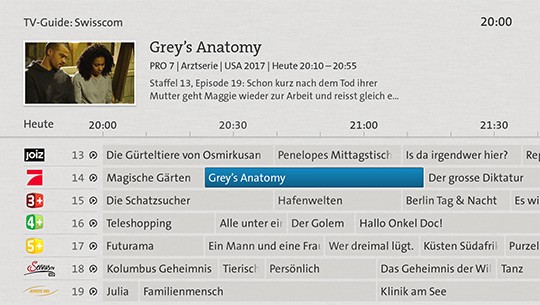
Head of Products & Marketing on Replay TV
“Replay is leading TV into the future.”
For several years now, there have been no time constraints to watching TV in Switzerland: Replay makes all programmes available at any time. But, what affect does this have on the television industry itself and how do audiences use it? Dirk Wierzbitzki, Head of Products and member of the Group Executive Board at Swisscom, sees it as the key to the future of television.
Roger Baur, 22 August 2018
Dirk Wierzbitzki, how popular is Replay among customers? Is it mainly for younger people?
(Laughs) That is the biggest misconception of all. No. Replay has become a mainstream option that cuts across all age groups. First of all, I need to explain what it is we do: conventional television works like a conveyor belt. I can only consume what is in front of me. Replay enables the audience to rewind back over the last seven days of programming. Therefore, alongside the conveyor belt, we create a pool where customers can save the programmes they want and access them flexibly throughout the week. This means that you don’t just have to watch Arena on Fridays from 10.20 pm until 11.45 pm. It is available from Friday at 10.20 pm around the clock for an entire week, at any time. It’s as if we’d set up a video recorder for each channel that records the programmes the customer wants 24/7. In the old days, the recorder was in the customer’s home and they had to plan what to record in advance. This now makes television attractive and responds to an important customer requirement; being able to watch when I have the time to do so.
Many broadcasters do not like this technology.
Perhaps this is simply because they are overlooking the fact that we are not changing anything or removing anything; in fact, we are expanding and broadening television’s appeal. Replay makes programme content much more accessible to the population at large, making it more widely viewed. You’ve got to look at it like this: our media consumption has completely changed over the last 10–15 years. Music is available on demand. Videos are available on demand. News is available on demand. Are we saying that television should be the only medium for which you need to set an alarm or break off from your evening meal? That’s nothing more than a reminder of a bygone era. For that reason, we, as a company – in the same way as our competitors – realised at an early stage that we needed to do something. We realised that the viewers had changed, that the content had changed. We therefore set out to help the broadcasters to reach their audience in this time of changing demands. And that’s what we have done. We have developed a system that, once activated by the customer, makes most broadcasters’ entire TV schedule for the past seven days available to the customer, regardless of whether the programme is broadcast at 3 am or at 8 pm.
And is there a demand for this?
Yes, because the viewing behaviour of a large proportion of the population has changed over the past seven years. Think about products such as YouTube and Netflix. Seven years ago, these really were the preserve of the younger generation and both of these have now become a part of mainstream television. You could even call it a revolution in customer requirements. With Replay, we have made conventional television competitive. We have built an entire ecosystem around the individual channels that goes way beyond simply “rewinding”. We have search functions that use written or spoken searches, including those in dialect, and this makes it really simple to browse the entire range of programming. You can browse by programme name, channel name, topic, person, or type. This all serves to stimulate growth in TV consumption. Remember: just a few years ago, you often heard people complaining that “good programmes are always on at the wrong time” or they “couldn’t find anything to watch”. Replay and our new format for presenting programmes have put an end to these two very different problems.

Watch the programmes you missed up to 7 days later: the TV-Guide is just one way to access Replay.
Shouldn’t each individual broadcaster be able to decide whether to offer Replay?
Yes, but then the whole system would break down. The current provisions were the only way to make this creative competition of concepts possible in the first place, bringing Swiss viewers one of the most cutting-edge services in the world. In those countries where individual negotiations are required with each broadcaster, the system is nowhere near as advanced. That’s because a solution like this is administratively unworkable in practical terms. It leads to red tape, favours the large international copyright holders and eventually results in a solution full of holes that drives viewers away.
That’s why I believe that we have a fair solution in Switzerland today – a solution for which we pay providers annual fees totalling more than 120 million Swiss francs for Live TV and Replay. As an example, in Germany, the individual channels have to organise and process Replay themselves; they even have to pay for their programmes to be broadcast on the cable channels. As a consequence, each broadcaster does its own thing, viewers don’t get an overview and the bottom line is that everyone loses out, because viewers move to other services. The idea that each broadcaster can arrange its own Replay sounds convincing in theory, but does not work in practice, as the current situation in Germany clearly demonstrates. As a result, viewers in Germany are turning away from conventional television and instead consume even more Netflix, YouTube and other streaming services that offer exactly this type of time-delayed viewing.
Is this also reflected in the advertising market?
Yes, which you can see if we stay with the same comparison: in Germany, broadcasters’ advertising revenue is stagnating. Compare this with Switzerland, where revenue has risen significantly compared with the period before the introduction of Replay. In Germany, only online advertising is growing; all other forms of advertising are losing revenue. I am convinced that Replay came along at just the right time to create a sustainable model for television. Without viewers, there is no advertising revenue.
But doesn’t Replay allow viewers to skip the ads?
Let me ask a counter question: would anyone watch the adverts at all without Replay? In fact, would anyone even watch the programme without Replay? The entire discussion around this reminds me of the start of the 80s, when the film industry wanted to ban the recording of TV films and took this to the US Supreme Court. Their action failed, the video recorder won through and this actually brought a golden period for the film studios, because the consumer continued to reward well-made programmes and consumed well-made advertisements.
I therefore regard Replay as an opportunity rather than a risk. In the 11 years since the new Telecommunications and Radio and Television Act came into force, Swiss commercial broadcasters have indeed focused on developing enhanced advertising methods, such as product placement or advertising spaces integrated into the programme itself. These more relaxed regulations have had an impact on commercial Swiss providers in particular. And we see from advertising statistics that they now earn disproportionately high advertising income.
So, could Replay even stimulate the TV market?
In light of the increases in advertising revenue in Switzerland, you can see that it’s already doing so. This is also reflected in the ratings, as here in Switzerland the viewing figures for programmes have been accumulated for up to seven days after broadcast over the last few years. Replay is therefore the model for the future. It allows television to seamlessly do two things at once: continue to broadcast in a linear fashion and also be available in a non-linear way. This is without the need for investment, without developing a secondary brand, without being absorbed by an international video giant. This is precisely what viewers want. They are now used to it and that is why they continue to grant television a privileged position in Switzerland. If that convenience is taken away, it will set off a chain reaction: viewers will be lost, Swiss broadcasters will be weakened, and the international content providers will be the ultimate winners. We cannot turn back time in terms of the media usage. Viewers will not accept a backwards step and will take their own action.
And there is something else to add: with Replay, the viewer has become accustomed to an alternative to using the remote control. Viewers interact with the screen, making it possible to use this to offer interactive advertising opportunities. We have introduced the technology required for this in recent years. Examples include the successor to Teletext HbbTV and the creation of a Swiss TV app store. If television can use the opportunities presented by these areas, then it can create a brand new experience and also open up brand new opportunities to establish additional income.
Profile
Dirk Wierzbitzki, 53, has managed the Products & Marketing division at Swisscom since 2016. He has been a member of the Group Executive Board since 2016.